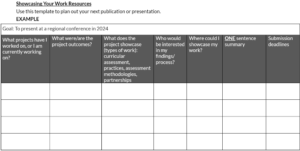IE and assessment professionals often wear many hats, and are not always thinking about how to translate our work into publication or presentations. However, the scholarship of assessment is growing, and all of us have value to contribute. Weave sat down with Drs. Tisha Paredes, Nick Curtis, and Gina Polychronopoulos, and discussed how to be proactive in turning your work into scholarship. (Based on the webinar “Showcasing Your Work: How to Present and Publish Assessment Work.”)
Types of Work to Share
It may not seem like it, but the creative processes and ideas you have around your daily work are probably unique. Sharing these activities with others could impact colleagues and students at many campuses.
Curricular Assessment
- Learning Outcomes Assessment (discipline specific, general education, institutional): Sharing your project’s interesting points that could transfer to another campus.
- Closing the Loop: Applying assessment findings for learning improvement is an evergreen topic we are all still working on.
Practices
- Faculty learning communities
- Meta-assessment
- Collaborative committees across disciplines
- Student affairs or co-curricular areas
- High impact practices
Assessment Measurements
- Instrument design, development, or refinement
- Assessment methodologies, cycles, or frameworks
Partnerships Inside and Outside of Your Institution
- National surveys (NSSE/FSSE, LibQUAL+)
- Content experts
- Other assessment professionals on or off campus
Hot Topics
- Diversity, Equity, and Inclusion (DEI)
- Partnering with students in assessment
- Collaboration with librarians
- Faculty development/Teaching & Learning
- Rubrics
- Actual impacts on student learning
Where to Share
As the scholarship of assessment has grown, so has the number of places showcasing it. There are so many options, it’s very likely you may find more than one to fit your topic.
Publications
- Journals/periodicals
- Professional blogs
Presentations
- Professional conferences
- Webinars, podcasts, YouTube
- Roundtables/Dialogue sessions
- Panels
- Poster Sessions
How to Share
It can be a little overwhelming to think of documenting and writing or presenting about your work. Following these steps can make it more manageable:
- What story do you want to tell?
- Start with “why” – why am I interested in sharing, why would others want to know, what problems did it set out to solve, what questions is it answering?
- Then “how” to best tell it – presentation, publication, etc.
- Summarize the “what” of how you did this work and what you found out.
- Who is the audience?
- Determine what publication is most appropriate by looking at previous articles.
- What are the requirements?
- Length, format, topic
- Get feedback from a colleague before submitting.
Make a Plan
It can be helpful to document and plan for success! We’ve created this helpful worksheet you can copy to get started.
Beginners/First Timers
Institutional Effectiveness and Assessment is a very collegial field and welcomes new recruits! If you are new to sharing your work, these low barrier (and low stakes) options are a great place to start.
- Serve on committees or boards
- Conference planning
- Professional organizations
- Volunteer for conferences – it’s like a backstage pass!
- Session host, registration desk
- See what people are looking for to learn how to craft your proposals
- Become a reviewer
- Journals and conference proposals are always happy to have help
- Start small and grow
- Begin with presenting at local conferences, then try state or regional, next national. At that point you will have enough feedback, revisions, and confidence to publish!
- For your first publication submission, consider a journal that will give feedback.
General Tips
- Being proactive is a good idea – as you begin a project, have a plan to document and then share your work.
- Answering WHY will help you determine WHERE to submit – different publications and conferences have different audiences.
- As long as your topic could be applied at another institution, there’s likely an audience for it.
- When considering where to submit, read their recent articles to see if they align with your idea. If not, look elsewhere. There’s an outlet for everything!
- Sometimes you don’t get accepted the first time – it’s okay. This is a friendly, collegial field! If your piece is rejected, it likely is just not an audience fit – try somewhere else.
- Network as often as you can, both in person and virtually – when you meet people with similar interests you could collaborate on a publication or presentation.
- Set a goal for yourself – how many submissions would you like to do this year?
- Consider cross-discipline conferences and publications that aren’t necessarily related to assessment: First Year Experience, Student Development, program specific events, etc.
Additional Resources
- Based on Showcasing Your Work: How to Present and Publish Assessment Work
- Register for Facilitating Partnerships with Faculty/Higher Education Assessment Professionals: Strategies for Success
- Where to Showcase Your Work
- Professional and Organizational Development Network – https://podnetwork.org/
- National Institute for Learning Outcomes Assessment publications – https://www.learningoutcomesassessment.org/publications/
- Assessment in Practice, Assessment Update, Viewpoints
- Association for the Assessment of Learning in Higher Education publications – https://aalhe.memberclicks.net/
- Intersection, Emerging Dialogues
- Peer-reviewed journals
- Journal of Research & Practice in Assessment (RPA) – https://www.rpajournal.com/
- The Journal of Assessment and Institutional Effectiveness (JAIE) – https://www.psupress.org/journals/jnls_jaie.html
- Intersection: A Journal at the Intersection of Assessment and Learning – https://www.aalhe.org/intersection
- Journal of Assessment in Higher Education (JAHE) – https://journals.flvc.org/assessment
- Regional conferences
- Accreditation Conferences: https://www.chea.org/regional-accrediting-organizations
- State Conferences: TxHEA, ANNY, Drexel University, Virginia Assessment Group
- National Conferences: Assessment Institute, AALHE




